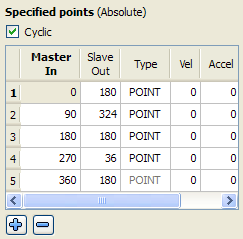Cam Profile Editor's Cam Table

-
-
These points could be different from those in the figure above, depending on the offsets and amplitudes specified in the cam profile (see "Create Cam Profiles") dialog box.
Table 6-6: Cam Editor - Table Parameters
About Cyclic Cam Element
 If the Cyclic check box is selected, the cam profile is executed cyclically. This means that, when the axis attached to this cam runs continuously, the same profile is executed again. In this case, the first and last element must have the same Vel and Accel values. Therefore, changing the Vel or Accel value of the first or last elements automatically changes the other elements' value.
If the Cyclic check box is selected, the cam profile is executed cyclically. This means that, when the axis attached to this cam runs continuously, the same profile is executed again. In this case, the first and last element must have the same Vel and Accel values. Therefore, changing the Vel or Accel value of the first or last elements automatically changes the other elements' value.
-
-
When Cyclic is first turned on, the Vel/Accel values will automatically be copied from the first element to the last element when they do not match. A warning dialog is displayed to inform you that this change has happened. This alert can be suppressed until KAS is closed.
There are some combinations of points and lines where Cyclic will automatically be turned off. If this occurs, the cyclic checkbox label will be changed to Cyclic (automatically turned off). The following changes to the profile will automatically turn off cyclic:
- The first element has been changed from a point to a line. If needed, cyclic can manually be turned back on which will affect the velocity of the last element.
- The next to last element has been changed from a point to a line and now both first and next to last elements are lines. Cyclic will be disabled and will only be re-enabled when the first and next to last elements are not lines.
- The first element is a line and the first element is moved. If needed, cyclic can manually be turned back on which will affect the velocity of the last element.
- The first element is a line and the second element is moved. If needed, cyclic can manually be turned back on which will affect the velocity of the last element.
- The first element is a line and the last elements velocity (or slope line) has changed. If needed, cyclic can manually be turned back on which will change the velocity setting just made.







